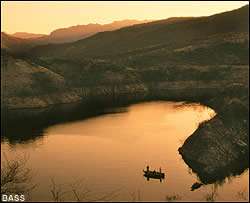
Here's a riddle for all you Bassmasters: What's man-made, contains heavyweight largemouth and receives little fishing pressure?
No, it's not some new reservoir in a remote section of Mexico or Zimbabwe. If you answered a mining strip pit or rock quarry, you've obviously already sampled these overlooked bass fishing treasures close to your home.
"A lot of strip pits are untouched, and the water is what really makes them special," says Brett Ware, president of Ambush Lures and a longtime strip pit angler. "They just seem to breed large fish. A lot of them are private, and big boats can't go on them, so they don't get the fishing pressure and that allows bass a chance to grow big."
Strip pits also hold plenty of aggressive bass in various sizes, as I found out last May while fishing with Ware on some of these abandoned mining holes in western Missouri. Runoff from rains earlier in the week had turned the water off-colored, and a cold front dropped the temperature into the 40 degree range when we descended into the pits. Yet despite the unfavorable conditions, I still managed to catch 25 bass, with the largest weighing about 3 ½ pounds.
Our outing was rated as a slow day by Ware, who has fished coal mining strip pits in Missouri and Illinois for more than 20 years. He claims that on good days, strip pits can yield 40 to 50 bass per angler — with possibly a dozen fish in the 5- to 8-pound range.
"Strip pits are unique bodies of water," claims Ware. "A lot of times they have really deep, steep banks that work up into some shallow water." The pits Ware frequently fishes have an average depth of 20 to 30 feet, and some of the long strips of water can stretch for one to two miles, yet might be only 40 yards wide.
"There is one thing about strip pits that a lot of people don't understand," advises Ware. "They think every strip pit is a good fishery, and that's just not the case. The ones that seem to be great fisheries usually have water running into them." During our pit-fishing trip, we tried several strips, and I noticed the most productive ones featured narrow corridors connecting into a chain of pits.
The steep walls and clear waters of a strip pit cause bass to suspend most of the time. So Ware prefers paralleling the bank and working an Ambush Lures Stealth Diver crankbait close to the wall. He opts for this lipless crankbait because it can be worked in the bass' strike zone (4 to 8 feet deep). The Stealth Diver also generates vibrations in the water without employing rattles, a key factor since Ware believes rattling crankbaits spook the fish in these clear water fisheries. His favorite crankbait hues include bone minnow, black-and-silver or blue-and-silver for fishing the clearest water, or purple firetiger for stained conditions.
The coal pits produce the biggest bass for Ware in spring (April and May). The deep waters of the pits limit weed growth, so anglers can fish the strips throughout the warmer months.
Bassmaster Tour competitor Sam Swett grew up fishing farm ponds and eventually graduated to gravel pits. He believes fishing the clear waters of southern Louisiana pits has helped him on the Tour, since it gave him the opportunity to learn how to fish deep with lighter tackle. The gravel pit waters have a visibility down 5 to 10 feet, as compared to other waters in south Louisiana, which at best have visibility of 2 to 3 feet.
The depth of the pits can range from 30 to 50 feet deep, and the banks are treacherous to walk, so Swett advises fishing from a johnboat or two man craft. "The gravel company dredges can go underneath the shoreline 20 or 30 yards, so you can be standing on a very thin shelf that can cave in on you," warns Swett.
The Covington, La., angler has discovered that older pits usually produce best, since these waters lack fishing pressure. "The banks of these pits are overgrown with grass, so it looks just like a regular pond and people won't mess with it," says Swett. However, the rocky bottom of a pit provides ideal spawning habitat and tends to hold more bass than a soft, mud bottom pond.
The lack of fishing pressure on older pits allows bass to grow older, but these fish are still less educated about lures. "The odds of catching a big fish is far greater there than going to a pit that is somewhat new," suggests Swett, who has taken one bass weighing more than 9 pounds from a pit, and several fish in the 5- to 8-pound range. "Some of the better bass caught in Louisiana that challenge the state record, have come from different pits across the state."
The deep pits offer a cool refuge for bass, so Swett prefers fishing these mining waters during the heat of summer. He recommends taking along a portable depthfinder to locate the rock shelves and any other structure in the pits. "After a pit has been abandoned, a lot of the banks start eroding and have washout points," advises Swett.
Other prime locations in gravel pits include shallow areas the gravel company shunned, since the spot contained mud rather than rocks. Swett believes bass are still attracted to these areas, because the bottom usually has a coat of sand over the mud. Laydowns and myrtle bushes that grow close to the bank and cast shade in the water are also key fish attractors in gravel pits.
The rocky bottom of a pit is ideal for working a crawfish imitator. Swett selects a 3 1/4-inch brown-and-orange Yum Craw Bug for bedding fish in the spring, and switches to a 4-inch Craw Bug in watermelon, watermelon/red flake or green pumpkin hues during the summer.
Since the pit floors contain gravel or sand, Swett steadily drags the craw on a football-head jig across the smooth bottom. "It looks like a crawfish in its natural defense mode," discloses Swett. The Louisiana angler opts for a 3/16- to 1/4-ounce jighead for shallow water applications and opts for a ½-ounce version when fishing in the 8- to 12-foot range.
Retrieving a Zara Spook or Zara Super Spook Jr. at a steady pace is another productive pit technique for Swett, especially if bass are suspended 10 to 12 feet deep. On cloudy days, he throws a black or black-and-chrome Spook, but switches to a Shore Minnow version in sunny weather. He opts for a firetiger or bullfrog pattern Spook if the water is dingy.
Flooded rock quarries also are big bass havens scattered throughout the country. Dick Mathews, a regional tournament angler from Lees Summit, Mo., catches plenty of high quality bass from a quarry close to his hometown. "One day, we caught two fish over 9 pounds, probably four in the 7-pound range, and more than 50 fish overall in three hours; and we were the only ones fishing it," claims Mathews. His favorite months for catching big fish from the quarry are March and April.
Although these fisheries have about the same depth as a strip pit, the quarries feature more gradual-sloping banks and pea gravel. The quarry Mathews fishes is big enough (200 acres) for him to launch his 20-foot Skeeter bass boat.
The Missouri angler works deep diving crankbaits, Chompers plastic grubs, and jigs along the quarry dam and steeper rock banks in the early spring. When the water temperature warms into the upper 60s and low 70s, Mathews concentrates on water lilies growing in the shallows, where he throws an Ambush Lures Pop-A-Long topwater bait.
If you want to stay close to home and catch a once-in-a-lifetime bass, your best bet is to find out where the local excavating company used to dig. You might uncover a bass fishing treasure closer than you ever imagined.





